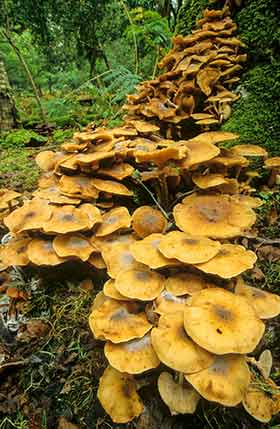Honey Fungus (Armillaria mellea)

the trunk of an unfortunate
host tree in Brinken Wood
Honey Fungus is common and widespread in the New Forest, which is good news for fungus enthusiasts but less so for the trees on which it grows, for this species is a parasite that causes extensive damage, and ultimately death, to its hosts.
Also known as the Boot-lace Fungus because its root-like cords, called rhizomorphs, by which it spreads, found beneath the bark of infected trees, on roots or in the soil, resemble bootlaces, Honey Fungus, as the name suggests, is of superficially similar colour to honey: ochre, tawny or darker brown.
It is primarily an autumnal fungus that grows in sometimes dense clusters on the trunks of both broad-leaved and coniferous trees, or nearby, growing from roots or buried branches.
The cap, which usually measures up to 10 centimetres across, often starts life as convex in shape before eventually flattening and becoming centrally depressed with wavy edges. Darker scales, particularly at the centre, are often also present.
The stem can reach a length of 12 centimetres, is initially whitish in colour before taking on reddish-brown hues, and initially has a thick, quite conspicuous, whitish to yellow cottony ring.
The gills are white at first, then yellowish and finally brown.
It is edible when young, but only when cooked, rather than raw, when it is mildly toxic.
Warning: refer to a good, comprehensive fungus field guide to confirm identification, and only eat those species known without any doubt whatsoever to be edible - people have died after eating certain poisonous specimens.
References:
Mushrooms and other Fungi of Great Britain and Europe - Roger Phillips
The Mushrooms and Toadstools of Britain and North-western Europe - Marcel Bon
Fungi of Britain and Europe - Stefan Buczacki and John Wilkinson
The MacDonald Encyclopedia of Mushrooms and Toadstools - Giovanni Pacioni
Fungi of the New Forest: A Mycota - Edited by Gordon Dickson and Ann Leonard
A Passion for Mushrooms - Antonio Carluccio
More links
Other related links
Search this site

Sadly, 58 animals were killed - 35 ponies, 13 cows, 8 donkeys and 2 sheep, whilst a further 32 were injured - 3 pigs, 9 donkeys, 11 cows and 9 ponies.
(Forty-three accidents occurred in daylight, 15 at twilight and 101 in the dark. Twenty-seven accidents were not reported by the driver involved).
Here's just one horrific example - Three donkeys killed in collision with van at notorious New Forest blackspot (Advertiser and Times)

